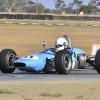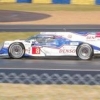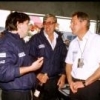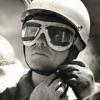Here is a brief excerpt from the upcoming book BEAST, which chronicles the behind-the-scenes stories of Ilmor Engineering and Penske Racing to build a special pushrod engine in a nearly impossible timeframe - and in total secrecy - for the 1994 Indianapolis 500. The book will be released by Octane Press in the coming weeks prior to the 20th anniversary of the 1994 500.
The rules for the 500 allowed a larger displacement and increased turbo boost for a single-cam pushrod engine. After Roger Penske and Ilmor’s Paul Morgan and Mario Illien made the decision to go forward with that configuration rather than the usual double-overhead cam engine, the work began on engine design. As a way to avoid designing an entirely new Penske chassis, Illien made the bold promise to package the larger pushrod engine into the PC23 chassis with the exact same connections (chassis, gearbox, cooling, etc.) as the Ilmor Indy D engine they would run at the remaining 15 races on the CART Series tour.
From the first line on paper to the engine's startup was only 26 weeks, accomplished by an immense number of 24-hour shifts.
For another excerpt and more book details, go to: http://fingerprint.typepad.com.
I hope you enjoy it. - Jade Gurss
Serious Brainpower
“Scientists investigate that which already is; Engineers create that which has never been.”
— Albert Einstein
With the parameters of the pushrod engine in place, chief designer Mario Illien assigned primary duties to his engineering and design team. No one on the staff had ever designed a pushrod engine, yet each person had a specific area to design, matching their background and expertise. The first official lines were drawn by hand Monday, July 19, 1993, slightly more than ten months before raceday.
“Keep in mind the sheer amount of work to get from a blank piece of paper to an engine,” said Philip le Roux, a South African designer who, like so many others on the team, had been hired by Ilmor directly out of university. He pointed out it wasn’t only the major components but “every nut, bolt, washer, and O-ring must be decided, and calculated for size . . . after that, there is no guarantee that when you screw them together they will fit, or run successfully on the dyno.”
Each designer was responsible not only for drawing the parts, but determining the manufacturing tolerances and what material to use. From basic aluminum to exotic compounds, each material has different attributes of strength, weight, density, fatigue, and expansion under extreme heat or pressure.
The decisions were complex and critical. In contrast to the wide-open Formula 1 rules, which allowed exotic and costly materials with catchy Ilmor nicknames like F.E.M. (****ing Expensive Material) and the mysterious Unobtanium, USAC rules for the 500 limited materials to save costs. For example, the valve gear had to be made entirely from titanium, stainless steel, or a similar ferrous alloy.
The designer also had to be certain that complex parts could even be made—whether by a craftsman or CNC machine. As for the manufacturing process, most tolerances were measured in increments of microns.
Because of the time concern, Illien and his team had to trust their instincts as they designed pieces without the benefit of the full picture. It was like throwing darts in the dark.
“I designed the crankshaft long before we committed to other things because it was the longest lead time,” explained Illien. “So, I had to make decisions very early on with things that I really didn’t know how they were going to end up.”
A crankshaft begins as a single piece of steel billet called GKHW, a metal that, when heat-treated and hardened, makes a very strong and durable component. Each step of the progression takes days or weeks as the billet is transformed through a number of milling, drilling, hardening, polishing, and grinding processes that shape it before the finishing and balancing procedures. The entire production takes twenty-three weeks, more than any other part in the engine. The crankshaft’s timeline set the bar for all other components.
The most pressing concern, however, remained the size of the engine.
“That was where I started: How do we fit it in the same space?” said Alan Cook, the designer in charge of the gear train and how each component would fit with all the other parts being sketched throughout the office.
“[Engine design is] an iterative process in that, ideally, you want to put component A in this space. Then you have to see if component B will fit, and that might mean moving A or even redesigning it,” Cook explained. “So things like a bearing, there’s going to be a hole for that bearing. But, there might be a cylinder stud coming down from another direction that dictates where it goes. So, moving everything around, you’d eventually come up with a solution that fits . . . designing something like this is a multidimensional jigsaw.”
Cook, a self-proclaimed perfectionist, would spend hours and hours imagining the 3D shapes from hand-sketched technical drawings.
“An engineering drawing tells someone what you want and how to make it,” said Cook. “So, checking engineering drawings for me was two parts. The first is checking to see that someone could make it from what’s there, and the second part is check that it fits all the parts around it. You might get all the pieces to fit from one side, but they may not fit at all on the other side. You know how you can buy wooden three-dimensional puzzles that initially you can’t put together? This is a bit like that: You’ve got to gradually move everything around until the three-dimensional puzzle fits together.”
Early on it was decided the pumps (oil and water pumps on the lower left side of the engine, and the scavenge pumps on the lower right side) would be the only common parts between the standard and pushrod engines. Everything else had to be designed and manufactured anew.
The gear train, a series of gears that look like the inner workings of a Swiss watch, and which provide power for the pumps and connect to the camshaft and alternator, was going to need a much thinner profile than Cook had previously encountered.
Cook explained, “On the standard Indy car V8, the cylinder spacing was smaller—the bore was smaller—so you’d have four-fifths of the engine length taken up, then you’d have the other fifth for the gear train and the pump drive. Now, the depth of the gear train was significantly less. So, we had to move the gears from the back to the front [of the engine] and wrap the pump drive around them somehow.
“The gear train was different, but all the principles were proven ones, so it was more puzzle than science,” said Cook, who took eight weeks to design it.
“The pushrod elements were going to be the biggest challenge because it was all new. My part of it just had to work.”
When it came to serious science, the top half of the engine was assigned to the young le Roux, who had been working on special Ilmor projects for Penske’s Pontiac NASCAR team. (NASCAR stock cars have used pushrod engines for decades.)
“[Illien] had drawn the side view of the engine with all the major components: the pistons and the driveshaft and a section showing all the dimensions,” le Roux recalled. “He asked me to lay out the cylinder head and the valve train, pushrods and the cam—everything from the top of the block upwards. I started on the drawing board, and I’d sketched where the crankshaft was and where the camshaft was.”
The camshaft was primarily the work of Ilmor’s resident professor, Jeff Williams. If one were to script a prototypical English university professor, Williams would be the template. Having helped in the early days of Ilmor while on a sabbatical from teaching, he remained an influential part of the company for nearly twenty years. He recently wrote a scholarly book on cam design that summarizes his experiences with the Ilmor pushrod engine.
“Paul [Morgan] came in with Mario and said, ‘We want you to do this pushrod engine,’” Williams explained.
“Pushrod?” Williams asked. “Right, well, you’re the boss. It won’t work very well. You won’t get the. . .”
Before Williams could finish, Morgan interjected, “Just do it.”
“He wanted me to do what I’ve always done, which is to do the analysis of working out all the forces and displacements and the shape of the cam. All that jazz,” said Williams. “And get it in a form that’s acceptable to the cam-grinding machine.”
“We need it quick,” Morgan said.
“How long? It will take at least six months,” replied Williams.
“Don’t be silly. You’ve got three weeks,” answered Morgan.
“Three weeks! You’ve got to be joking!”
“Well, that’s what you’ve got,” Morgan said.
“Eventually it did take me three or four months to complete,” said Williams. “But it was about the worst three or four months of all time.”
Alan Cook, a protégé of Williams, disagreed with his mentor’s assessment.
“It was the happiest time I’ve ever had at work,” said Cook. “While it was work, everyday you were doing what you wanted to do. So, brilliant! If I had chosen what to do each day, I would have chosen this.”
When asked if it was a sacrifice, Cook was quick to reply. “It wasn’t a sacrifice because sacrifice implies to me that you’re not doing something else instead of this. This is what I wanted to do.”
One key decision for Illien was the V angle of the two banks of cylinders in the block. The standard Ilmor engine for 1994 was designed with a V angle of eighty-two degrees, but Illien chose a seventy-two-degree angle for the pushrod engine. The tighter angle allowed the camshaft to move higher, resulting in shorter pushrods. Shorter pushrods were critical to maintain control of the valve train at high RPMs. This meant the pushrods—and the entire mass of the valve train—had to be compact and lightweight, yet sturdy with very low friction.
Engine design is a series of compromises. The short length of the block defined the cylinder circumference. “The cylinder head had to be [done in] 3D. It was very complex,” Illien said of a major component that would hold everything exactly in place. “That was the first cylinder head design where we used the CAD system. It would be difficult to do with pencil and paper.”
It was a primitive early version of the software, but le Roux put it to good use with the help of fellow designer Geoff Oliver.
“I began working on an early CAD thing, which was just a wireframe picture,” said le Roux. “It wasn’t all rendered or even looked like something real. It was just the edges you could see. It was great. It was the first time I was really working in 3D, and because you were just looking at the edges, not surfaces, sometimes you’re not sure if you’re looking at the back or the front. I could lay out the valves and see if the pushrods made it on the cam. Then, I’d make a print-up to give to Mario and he would look at it.”




























